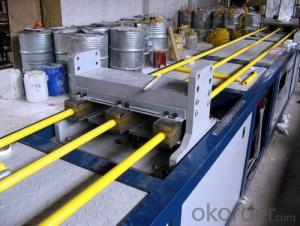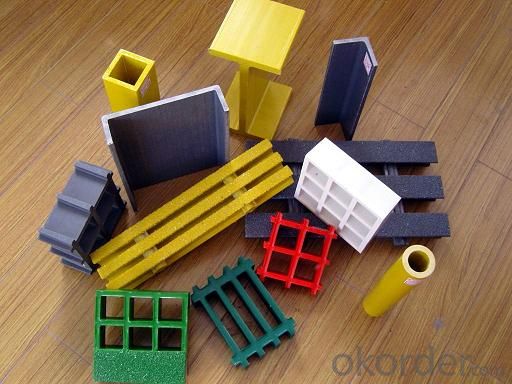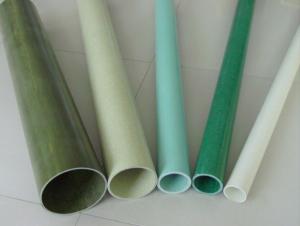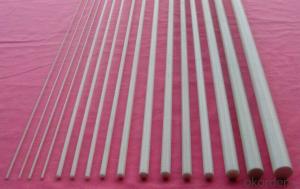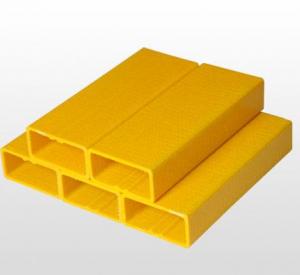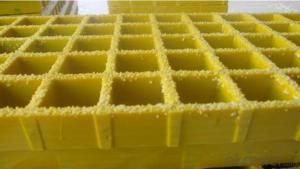FRP Pultrusion Profiles - Guardrail and Ladder
- Loading Port:
- Shanghai
- Payment Terms:
- TT OR LC
- Min Order Qty:
- 70 m
- Supply Capability:
- 80000 m/month
OKorder Service Pledge
OKorder Financial Service
You Might Also Like
Specification
PRODUCT DESCRIPTION
FRP guardrail are made by assembling of FRP pultrusion profiles. They divided into four types, they are standard square type, economic type, standard round type and heighten type, the type of profile and the installation distance, height, position and quantity can be changed per the customer’s requirement, the color also could be selected according the client’s demand.
FEATURES
a. anti-corrosion, anti-rust
b. light weight and high strength
c. vivid color
d. anti-ageing
e. good property of non-magnetism
f. safety
Technical data
Standard Square type
Handrail | Rung | Post | Kick plate |
Square tube 50*50*4 | Square tube 50*50*4 | Square tube 50*50*4 | Flat panel 101.6*3 |
Economic type
Handrail | Rung | Post | Kick plate |
Channel 57*60*3 | Square tube 38*38*4 | Square tube 50*50*4 | Flat panel 101.6*3 |
Standard round type
Handrail | Rung | Post | Kick plate |
Round tube φ50*4 | Round tube φ50*4 | Round tube φ50*4 | Flat panel 101.6*3 |
Heighten type
Handrail | Rung | Post | Kick plate |
Channel 57*60*3 | Round tube 32*3 | Square tube 50*50*4 | Flat panel 101.6*3 |
PICTURES
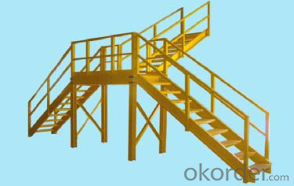

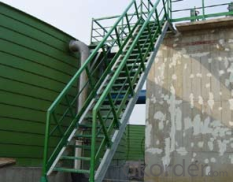
- Q: What is the maximum length of FRP pultrusion profiles that can be manufactured?
- The maximum length of FRP pultrusion profiles that can be manufactured depends on various factors such as the type of material used, the manufacturing process, and the equipment available. However, it is generally feasible to produce FRP pultrusion profiles with lengths ranging from a few feet to several hundred feet.
- Q: Can not use glass steel support column, the main support for the door
- Can not. Strength is not good. It is recommended to use FRP for exterior decoration, with steel skeleton inside.
- Q: What are the best manufacturers of glass fiber reinforced plastic pultruded profiles in China?
- We have made 2.5mm thick at the moment
- Q: Are FRP pultrusion profiles fire resistant?
- Yes, FRP pultrusion profiles are fire resistant.
- Q: What is the impact resistance of FRP pultrusion profiles?
- The impact resistance of FRP pultrusion profiles is generally high due to the inherent strength and durability of the fiberglass reinforcement. The specific impact resistance may vary depending on factors such as the resin type, fiber orientation, and manufacturing process. However, FRP pultrusion profiles are known to exhibit excellent resistance to impacts and can withstand heavy loads and external forces without experiencing significant damage or deformation.
- Q: Can FRP pultrusion profiles be used in the agricultural and farming industry?
- Yes, FRP pultrusion profiles can certainly be used in the agricultural and farming industry. FRP (Fiber Reinforced Polymer) pultrusion profiles are known for their high strength, durability, and resistance to corrosion, making them ideal for outdoor and harsh environments such as those found in the agricultural and farming industry. These profiles can be used for various applications in agriculture and farming, including: 1. Fencing and enclosures: FRP pultrusion profiles can be used to create sturdy and long-lasting fences, gates, and enclosures for livestock and crop protection. The profiles are resistant to rot, rust, and insect damage, providing a reliable barrier for animals and crops. 2. Structural components: FRP pultrusion profiles can be used as structural components in agricultural buildings, sheds, and greenhouses. Their high strength-to-weight ratio allows for the construction of lightweight and durable structures that can withstand extreme weather conditions. 3. Irrigation systems: FRP pultrusion profiles can be used in the construction of irrigation systems, such as pipes, channels, and culverts. These profiles are non-corrosive and have a smooth interior surface, reducing friction and improving water flow efficiency. 4. Equipment support and framing: FRP pultrusion profiles can be used to provide support and framing for various agricultural equipment, such as conveyors, platforms, and machinery. Their high strength and stiffness make them suitable for heavy-duty applications. 5. Animal housing and equipment: FRP pultrusion profiles can be used to construct animal housing and equipment, such as pens, stalls, and feeding troughs. These profiles are resistant to chemicals, moisture, and UV radiation, ensuring a long lifespan and low maintenance requirements. In summary, FRP pultrusion profiles can be successfully utilized in the agricultural and farming industry due to their excellent mechanical properties, resistance to environmental factors, and versatility in various applications.
- Q: Can FRP pultrusion profiles be used in electrical insulation applications?
- FRP pultrusion profiles are capable of being utilized in electrical insulation applications. They possess exceptional electrical insulation properties, rendering them appropriate for a broad range of electrical applications. The superior dielectric strength of FRP materials ensures the efficient containment of electrical currents within designated pathways, thus preventing leakage and electrical hazards. Moreover, FRP profiles exhibit low electrical conductivity, thereby decreasing the likelihood of electrical shorts and enhancing overall safety in electrical insulation applications. The non-magnetic characteristics of FRP materials are also advantageous as they eliminate the potential for electromagnetic interference (EMI) in sensitive electrical systems. Furthermore, FRP pultrusion profiles are lightweight, resistant to corrosion, and boast a lengthy operational lifespan. This renders them an economical and robust solution for electrical insulation applications.
- Q: Are FRP pultrusion profiles resistant to chemicals used in food processing?
- Yes, FRP (Fiber Reinforced Plastic) pultrusion profiles are highly resistant to chemicals used in food processing. They are specifically engineered to withstand harsh chemical environments, including the cleaning and sterilization agents commonly used in food processing facilities. This resistance makes FRP pultrusion profiles a suitable material choice for various applications in the food industry where chemical resistance is crucial.
- Q: Can FRP pultrusion profiles be used in cooling towers?
- Cooling towers can indeed utilize FRP (Fiber Reinforced Polymer) pultrusion profiles. These profiles possess several advantages that make them suitable for such applications. To begin with, the corrosion resistance of FRP pultrusion profiles is exceptional, a crucial attribute in a cooling tower setting where exposure to water and chemicals is commonplace. Unlike conventional materials like steel, FRP pultrusion profiles do not rust or corrode, ensuring a longer service life and reduced maintenance expenses. Secondly, FRP pultrusion profiles exhibit a high strength-to-weight ratio, rendering them lightweight yet sufficiently robust to meet the structural demands of cooling towers. This facilitates easier installation and transportation, ultimately reducing the overall project costs. Thirdly, FRP pultrusion profiles boast excellent thermal insulation properties. As cooling towers involve the transfer of heat from water to the surrounding air, the thermal insulation provided by these profiles enhances the efficiency of the cooling process. Lastly, FRP pultrusion profiles are highly customizable and can be tailored to meet the specific requirements of cooling tower applications. They can be engineered to possess various shapes, sizes, and dimensions, ensuring a precise fit for the cooling tower design. Overall, FRP pultrusion profiles represent a dependable and cost-effective choice for cooling tower applications. Their corrosion resistance, high strength-to-weight ratio, thermal insulation capabilities, and customization options make them an excellent option.
- Q: Can FRP pultrusion profiles be used in the construction and building materials industry?
- Yes, FRP pultrusion profiles can be effectively used in the construction and building materials industry. These profiles offer several advantages such as high strength-to-weight ratio, corrosion resistance, and dimensional stability, making them suitable for a wide range of applications including structural elements, handrails, gratings, and reinforcements. Additionally, FRP pultrusion profiles can be easily customized to meet specific project requirements, making them a popular choice in the industry.
Send your message to us
FRP Pultrusion Profiles - Guardrail and Ladder
- Loading Port:
- Shanghai
- Payment Terms:
- TT OR LC
- Min Order Qty:
- 70 m
- Supply Capability:
- 80000 m/month
OKorder Service Pledge
OKorder Financial Service
Similar products
Hot products
Hot Searches
Related keywords
